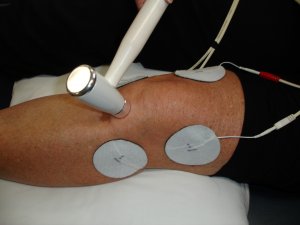Laurie's Blogs.
Sep 2017
How many therapies in one treatment?
Some of you may have seen this question and answer on the VetRehab Chat group…. I wanted to expand on my answer a bit further here. For those of you who didn’t see it or are not on the VetRehab chat group, I’ll give you the gist of the question.
A vet asked the group about whether or not using multiple modalities in one treatment session had the potential to reduce the effectiveness of either one treatment modality on its own. i.e. should she use LASER and TENS for hip osteoarthritis pain? A colleague of the questioner had told her to only use modality per session, but she had learned to use both. Which of them was correct?
Here’s my reply:
It is often very common and actually valuable to use the different modalities on a patient during a single therapy session. While many of the modalities work towards the same goal (i.e. pain management, healing of tissues, blood flow, etc), they work via different mechanisms. So combining them could enhance, not detract from, your outcomes!
Where your confusions might lie, is that if you were to do research, and you wanted to validate laser for a certain condition (for example), if you used multiple therapies, you would not be able to say what the effects of laser were - so it might confuse the findings.
But it is very good practice to combine therapies and/or modalities clinically. To not do so could be considered ‘under-treating’ and inappropriate case management.
Now let’s elaborate:
TENS affect pain via the gating mechanism in the spinal cord, endorphin release, enkephalin release, release of excitatory neurotransmitters, and selective stimulation of large diameter peripheral nerve fibres which in turn help to block nociceptive activities in smaller afferents at segmental levels. If using low frequency tens, then there is also stimulation of endogenous opiates.
PEMF can stimulate healing (collagen synthesis), and may help with pain via increasing circulation and oxygen utilization (speculative).
MICROCURRENT may not have the research to show HOW it works, but there is research that shows it helps with pain management, mood, anxiety, relaxation, time for wound closure, and improved functioning after orthopaedic surgery.
NMES over-rides that volitional control of muscle contraction, and in doing so may help with disuse atrophy or muscle firing sequences. As well, because the muscles are contacting, there can be an increase in blood flow, which may also help with healing and/or joint swelling, and pain. It may also have pain modulating effects as it is very similar to TENS.
LASER (my favourite) can stimulate collagen production, fibroblastic or osteoblastic activity, angiogenesis and enhances immune cells, thereby helping to heal tissues. It also causes an increase in blood flow, endorphin release, and may inhibit transmission at the neuromuscular junction (all of which may reduce pain).
ULTRASOUND may help with tissue repair, bone repair and reduction of swelling (pulsed) and continuous ultrasound could additionally heat the tissues, which could cause a mild inflammatory reaction and stimulate healing. Theoretically, it could help with pain management via pain gating, increased nerve function and blood flow.
SHOCKWAVE stimulates the following biological responses: enhances neovascularization, accelerated growth factor release, selective neural inhibition, osteogenic stem cell recruitment and inhibition of molecules that have a role in inflammation. As such this modality may help with healing and with pain management.
Manual Therapies have been shown to have pain reduction effects (incorporating local, spinal, and supraspinal systems as well as utilization of the endocrine system as well), and healing effects (stimulating collagen synthesis and blood flow).
EXERCISE not only helps with building muscle which may be protective for joint pain, but also improves blood flow and has an effect on the endocrine system as well.
ACUPUNCTURE has oodles of effect, but to minimize them for this blog, let’s say it helps with pain management (endogenous opiod release, stimulation of peripheral, spinal and supraspinal pain control centres), increases blood flow, and effects that can be categorized as ‘durotaxis’, ‘mechanotransduction’ and ‘mast cell degranulation’.
All in all, why deny a patient any of these potential effects and different way to achieve them? Really, time and access to the tools could be all that stops one from using everything at your disposal to help a patient in pain or deteriorating function. So, feel free to use what makes sense in your practice! The combining of your tools could make your treatments darn near MAGICAL!
Happy practicing!
Cheers,
Laurie



